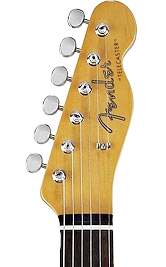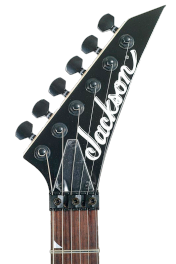Guitar Re-Stringing.
This page will help give you some basics. Poor re-stringing of your guitar will mean unstable tuning, or in some cases the string will break once up to tension.
Guitars With A Standard Nut.
When putting a new string or maybe a whole new set of strings on, there are some really important things to get right. If you a re removing all the strings, then definitely clean the fingerboard of the neck to make sure you don't put muck immediately onto the new strings and dull their tone really quickly.If your machine heads are not locking machine heads (these clamp the strings in the whole that runs through the post of the machine head) then you will want some turns of the string on each machine head. The number of turns will change ideally with the gauge of the string, thick bottom-E strings 1.5 - 2.5 or so, thin top-E strings maybe 5 turns (at least 3). This makes sure with the thin strings there are several turns to aid friction and not put all the strain on the string where it bends into the hole in the machine head, thicker ones to make sure there is not too much string in use.
When adding these turns, make sure the string goes down the machine head in a neat spiral from the hole before heading down the neck, keeping all the windings below the string coming out of the hole. This helps hold the string down onto the nut.
Give your strings a bend or two after getting them in tune initially, to try and settle them down quickly. With steel strung guitars a stable tuning should be obtained quite rapidly.

Guitars With A Locking Nut.
A locking nut like the one on the right here, is quite a different proposition. Once you release the locking nut to remove the old strings, make sure you put the fine tuners that are part of the tremolo system into the middle of their travel to allow the best possibilities when fine tuning at the end of the process. If this is forgotten, you will be more likely to have to unlock the nut again to get the tuning right.The same things apply to these guitars when restringing that are mentioned above, cleaning the fingerboard and using the appropriate number of turns on the machine head.
With floating tremolo systems, it can also prove much easier and quicker to re-tune the guitar if you are removing all the strings to use some folded up card underneath the back of the tremolo block to try and stop the tremolo moving too far back into the body, and increasing the time it takes to bring the strings up to concert pitch again.
Nylon Strung or Classical Guitars
Sometimes these strings can prove more fiddly and can when using cheaper nylon strings require some 'tricks' to stop the thinnest strings slipping off the machine heads. With these, we will generally try to keep the number of turns down on the machine head, as they mainly contribute to how long it takes for the strings to reach a stable tuning.We will be starting with the top-E string, tying the string at the bridge end first, with the end of the looping knot following out towards the other strings, and we'll catch that in the loop of the next string, going on like this towards the bottom-E string.
Now looking at the headstock end of things, again start with the top-E. Turn the machine head until the hole is pointing towards you looking from the font of the headstock. Feed the string over the shaft, then put the string through the hole poking it back out the front. Loop the string over itself where it goes past the front of the hole then back down the hole again and pull firmly out the back.
You should now tune the string up to the pitch required, holding some tension onto the string by pulling it away from the fingerboard with your other hand while you take up the slack with the turning of the machine head. This helps to put tighter turns onto the machine heads and reduce the time it takes to get stable tuning.
© 2014 Karn Broad Contact Karn
